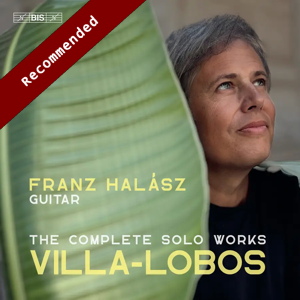
Heitor Villa-Lobos (1887-1959)
Complete Works for Solo Guitar
Douze Études, W235 (1928)
Suite Populaire brésilienne, W 020 (1923-1928, 1948)
Valse-Chorus, (1920s)
Chôros No. 1 (Chôro típico), WB 161 (1920)
Valsa Concerto No.2, W 009 (1904) completed by Débora Halász
Cinq Préludes, W 419 (1940)
Franz Halász (guitar)
rec. 2024, München Schwabing, Germany
BIS BIS-2735 SACD [83]
Franz Halász invests these performances with great emotion, primarily that of the obvious joy with which he approaches them. He is, of course, a guitarist with a considerable technique at his disposal. He was the winner of first prize in Spain’s Andrés Segovia Competition and the Seto-Ohashi International Competition in Japan. At times, he seems almost to take minor liberties with the scores, but these only result in a more comprehensive reading of the music than one finds in the interpretations of more meticulous guitarists. His phrasing is occasionally rather individual but always convincing. Though years of study and practice must underlie these performances, they feel very spontaneous.
Villa-Lobos’s works for solo guitar are not as numerous as one might hope. There are 12 Études and 5 Preludes (a sixth seems to have been lost). The Suite Populaire brésilienne is made up of five short pieces – ‘Mazurka-Chôro’, ‘Schottisch-Chôro’, ‘Valsa-Chôro’, ‘Gavotta-Chôro’ and ‘Chôrinho’. The programme of the disc is completed by the Valse–Chôro, the Chôros No. 1 and the Valsa-Concerto No.2 (completed by the pianist Débora Hálasz, Brazilian wife of the guitarist.
Though all the works on the disc have an excitement of their own, certainly as played by Franz Halász, there are some important differences; the Preludes and the Études are, in part, ‘didactic’ pieces – an aspect well-described by the Cuban novelist and musicologist Alejo Carpentier: “His preludes and études are to guitarists what the Preludes and Fugues of Bach’s Well-tempered clavier have been to pianists of every generation – a basic key text that besides the problems of its technical execution, is a highly articulate form of musical communication” (‘The Angel of the Maracas’, Music Education Journal, 61:9, 1975, pp.43-47. My quotation is from pages 46-47). The Preludes, like most of Villa-Lobos’s music draw on Brazilian traditions as well as European music. Take Prelude 1 – in his booklet notes accompanying this disc, João Mauricio Galindo observes that in the prelude one can hear the composer’s love of “the romantic lyricism of Frédéric Chopin”, which is true enough. But around bars 50-56 one can also hear echoes of Brazilian folk music, specifically the music of the rural areas of the state of Sao Paolo – known as sertaneja music. In the reprise which closes this Prelude, such echoes mix with reminiscences of Chopin.
The Études were composed in 1928, at the suggestion of Segovia. The Préludes were written in 1940; originally there were 6 Préludes. Segovia was presented with a complete set of the études and preludes, but the sixth seems mysteriously to have disappeared from the apartment of the great Spanish guitarist.
The Préludes represent Villa-Lobos’ writing for solo guitar at something like its most mature and, fittingly, it is in their performance here by Franz Halász that one hears this fine guitarist at his best. His performance of these five pieces is so good that it alone is enough to make this disc highly recommendable. The Préludes were, it appears, written a set of discrete pieces rather than as a unified cycle, but Halász repeatedly makes one aware of links and mutual echoes. In Prélude No. 1 – ‘Homenagen ao Malandro Carioca’ – his reference to popular Brazilian traditions is very evident, at times reminiscent of sertaneja music, particularly common in the south of the country. Villa-Lobos himself spoke of this Prélude as “a tribute to Brazilian country music” (quoted thus in Humberto Amorim, Heitor Villa-Lobos: uma revisão bibliografica e considerações sobre a produção violinistica, Rio de Janeiro, 2007, p.202). Prelude No. 2 – ‘Homenagem ao Malandro Carioca – Melodia Capadócia – Melodia Capoeira’, as its title makes clear, is concerned with several different traditions of Brazilian music: ‘Malandro Carioca’ refers to the street musicians of Rio de Janeiro (Carioca is a term for a resident of Rio as well as the name of a dance), while Malandro Capadócia refers, I believe, to a mischievous character associated with the Rio Carnival. Capoeira is a musical tradition, dance (and martial art), which developed amongst African communities enslaved in Brazil. This Prélude belongs broadly in the tradition of the choro, the urban musical tradition of Brazil, full of syncopated rhythms and the use of altered tempos and rhythms – a vital, lively music, which Villa-Lobos himself thought the most perfect expression of the Brazilian spirit.
Unlike its two predecessors, Villa-Lobos’ Prelude No.3 – ‘Homenagem à Bach’ hardly contains any purely Brazilian references. Obviously enough, Johann Sebastian Bach is the major influence here, handled with sensitivity and sophistication in Villa-Lobos’ writing and, indeed, in Franz Halász’s playing. Preludes No. 4, ‘Homenagem ao Indio Brasileiro’, and No.5, ‘Homenagem à Vida Social’ require no lengthy discussion, nor should this part of my review be expanded still further. I will leave the Préludes by recommending to any interested reader a valuable analysis of all five of them by Tetiana Filatova, in English and available as a free download from the Studia Universitatis Babeş-Bolyai. Musica journal (December 2024).
My fascination with Villa-Lobos’ Préludes has perhaps led to my overlooking the lesser works in this collection. I will, therefore, add that Halász characterises very vividly the five miniatures of the Suite Populaire brésilienne and makes the ‘Valse Chôro’ and the ‘Valsa Concerto No. 2’ sing and dance. His performance of the 12 Etudes is dashing and convincing.
In short, I don’t know of a better introduction to the guitar music of Heitor Villa-Lobos and can scarcely imagine that one will appear any time soon. The recorded sound is all that one could hope for.
Glyn Pursglove
Buying this recording via a link below generates revenue for MWI, which helps the site remain free.




















